A Better Sense of Place
2016 May 22 (Sun)
Progress report
It's been a long time since I've shared pictures of the yard and not just close-ups of plants. For everyone who's questioned how things are actually going these days, today's the day. (Except for the back alley. I didn't actually take a picture of it this time.)
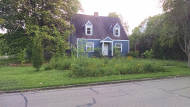 I'll start this tour from the street. Imagine yourself driving around in your expensive air-conditioned car, thinking about your property value because you bought your current house as an investment and not as a shelter. You round the corner on the way back to your investment and see this mess. "What is this? Isn't the homeowner paying some third party to mow this? How dare nature invade the suburbs! We need to control this before it gets out of hand! My property value!" Let me tell you what I see: Shumard oak, witch hazel, redcedar, magnolia, American hornbeam, red maple, black tupelo, American beautyberry, arrowwood viburnum, possumhaw viburnum, tulip trees, asters, coreopsis, mistflower, red chokeberry, broomsedge, and little bluestem. I see biodiversity coming back to Baton Rouge.
I'll start this tour from the street. Imagine yourself driving around in your expensive air-conditioned car, thinking about your property value because you bought your current house as an investment and not as a shelter. You round the corner on the way back to your investment and see this mess. "What is this? Isn't the homeowner paying some third party to mow this? How dare nature invade the suburbs! We need to control this before it gets out of hand! My property value!" Let me tell you what I see: Shumard oak, witch hazel, redcedar, magnolia, American hornbeam, red maple, black tupelo, American beautyberry, arrowwood viburnum, possumhaw viburnum, tulip trees, asters, coreopsis, mistflower, red chokeberry, broomsedge, and little bluestem. I see biodiversity coming back to Baton Rouge.
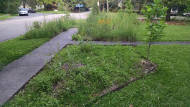 The front yard "mess" doesn't go that far back. I have intentionally left spaces for the mail person to walk diagonally across the lawn to the front door and down the front walk to across the street. I also have a potential play area near the house that's turf grass. And I opened up a path that continues the sidewalk over to the side street. (When we moved in, it was blocked by plants.) The bed in the foreground is new from February and March. I didn't completely remove the St. Augustine grass like I usually do because I really needed to sow the seed mix I bought. Because of this, the turf grass is starting to come in strong. But I also have some sprouts of native grasses, so it's an experiment with how well native grass can outcompete turf grass. As for the older bed in the background, I'm proud to say the little bluestem, backbone of the prairies, is starting to establish itself.
The front yard "mess" doesn't go that far back. I have intentionally left spaces for the mail person to walk diagonally across the lawn to the front door and down the front walk to across the street. I also have a potential play area near the house that's turf grass. And I opened up a path that continues the sidewalk over to the side street. (When we moved in, it was blocked by plants.) The bed in the foreground is new from February and March. I didn't completely remove the St. Augustine grass like I usually do because I really needed to sow the seed mix I bought. Because of this, the turf grass is starting to come in strong. But I also have some sprouts of native grasses, so it's an experiment with how well native grass can outcompete turf grass. As for the older bed in the background, I'm proud to say the little bluestem, backbone of the prairies, is starting to establish itself.
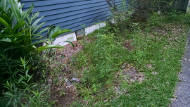 Continuing up the driveway along the side of the house is this pseudo bed. It may not look like much, but I know for a fact that there's mayhaw, parsley hawthorn, big bluestem, partridge pea, and even a baldcypress. I've committed to making this spot a grass-heavy area, and grass takes a while to mature.
Continuing up the driveway along the side of the house is this pseudo bed. It may not look like much, but I know for a fact that there's mayhaw, parsley hawthorn, big bluestem, partridge pea, and even a baldcypress. I've committed to making this spot a grass-heavy area, and grass takes a while to mature.
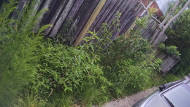 At the end of the driveway is this narrow area with the worst soil on the planet. We've got dogfennel, lateflowering throroughwort, boneset, partridge pea, virgin's bower, various grasses that have yet to be determined, lanceleaf coreopsis, American basketflower, wax myrtle, and winged sumac. (And there's also a non-native bottlebrush.)
At the end of the driveway is this narrow area with the worst soil on the planet. We've got dogfennel, lateflowering throroughwort, boneset, partridge pea, virgin's bower, various grasses that have yet to be determined, lanceleaf coreopsis, American basketflower, wax myrtle, and winged sumac. (And there's also a non-native bottlebrush.)
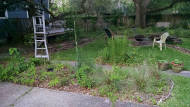 On the other side of the end of the driveway is this new bed I made last fall. This is where I used to have my four Arbor Day Foundation glossy abelia bushes. They went to crap in the heat of the summer, so I pulled them up and made this a real bed. In it are Turk's cap, purple coneflower, basil, rosemary, spearmint, jalapeño, bell pepper, partridge pea, gulf muhly, blazing star, scarlet sage, pink evening primrose, and the really tall rattlesnake master (that's just about to start flowering). On the other side of the walkway there's also some more dogfennel and mealy blue sage. Trailing off into the distance from behind that metal ladder that's holding up the live oak branch are Florida anise, royal fern, sensitive fern, Southern shield fern, penstemon, woodland oats, and some more stuff I'll mention with the next picture.
On the other side of the end of the driveway is this new bed I made last fall. This is where I used to have my four Arbor Day Foundation glossy abelia bushes. They went to crap in the heat of the summer, so I pulled them up and made this a real bed. In it are Turk's cap, purple coneflower, basil, rosemary, spearmint, jalapeño, bell pepper, partridge pea, gulf muhly, blazing star, scarlet sage, pink evening primrose, and the really tall rattlesnake master (that's just about to start flowering). On the other side of the walkway there's also some more dogfennel and mealy blue sage. Trailing off into the distance from behind that metal ladder that's holding up the live oak branch are Florida anise, royal fern, sensitive fern, Southern shield fern, penstemon, woodland oats, and some more stuff I'll mention with the next picture.
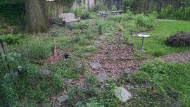 The grand experiment which is the shaded rain garden looks like this now. I realize now that annuals will generally not grow here because of all the live oak leaf litter. What's doing well are American beautyberry, Southern woodfern, inland seaoats, parsley hawthorn, strawberry bushes, Virgina sweetspire, sweet pepperbush, cutleaf daisy (oddly), trillium, Indian pink, and swamp sunflower. Once things grow up and fill in, it'll make more sense.
The grand experiment which is the shaded rain garden looks like this now. I realize now that annuals will generally not grow here because of all the live oak leaf litter. What's doing well are American beautyberry, Southern woodfern, inland seaoats, parsley hawthorn, strawberry bushes, Virgina sweetspire, sweet pepperbush, cutleaf daisy (oddly), trillium, Indian pink, and swamp sunflower. Once things grow up and fill in, it'll make more sense.
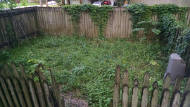 And finally, the Chicken Yard. It's definitely a confusing place, but I think it's because there were just so many dormant sedge seeds back when I cleared the area almost 3 years ago. The sedge is generally re-established along with plenty of lanceleaf coreopsis, oakleaf hydrangea, Eastern redbud, purple coneflower, Virigina creeper, and two questionable red mulberry sticks. I intended this area to be dominated by those red mulberry, but if they don't take I'll need to rethink my idea.
And finally, the Chicken Yard. It's definitely a confusing place, but I think it's because there were just so many dormant sedge seeds back when I cleared the area almost 3 years ago. The sedge is generally re-established along with plenty of lanceleaf coreopsis, oakleaf hydrangea, Eastern redbud, purple coneflower, Virigina creeper, and two questionable red mulberry sticks. I intended this area to be dominated by those red mulberry, but if they don't take I'll need to rethink my idea.
So there you go. This is what things look like after a mere 4 years of starting from scratch and learning as I go. It was only 2012 when I started planting natives and 2013 when I dug up the area for the rain garden. Maybe if I had done this all before, things would be a little further along.


